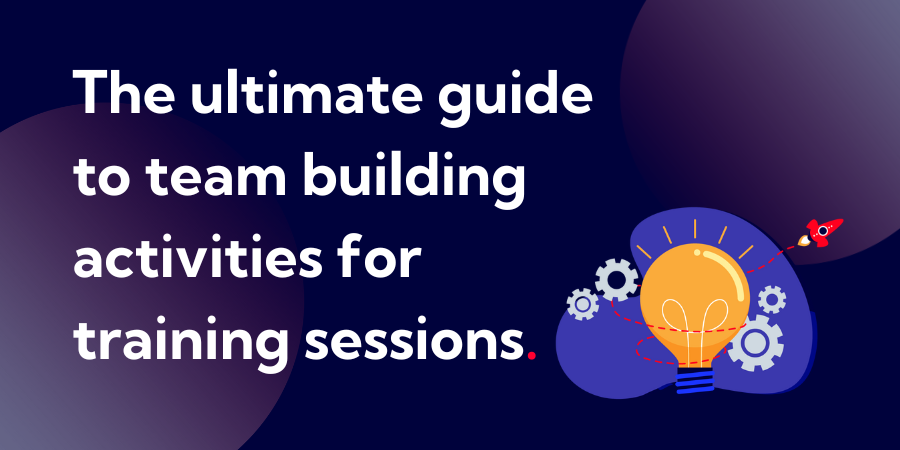The ultimate guide to team building activities for training sessions

The most memorable training sessions are the ones where delegates connect, share ideas and feel genuinely engaged with the material and each other. Whether you are running a compliance course, leadership workshop or technical training session, the atmosphere in the room can make a huge difference to how people learn.
That is where team building comes in. For training providers, they are about helping delegates build confidence, communicate more effectively and collaborate during learning. When people feel relaxed and connected, participation improves and knowledge retention increases.
From the Marshmallow Tower and the Paper Bridge, communication exercises such as Blind Drawing and the Communication Chain, to reflective activities like the Scenario Challenge and Debrief Circle, the best team building activities for training sessions usually include problem-solving tasks. These exercises help delegates get the most from their learning experience.
This guide brings together a range of team building and icebreaker activities that are designed for use within training sessions. From quick warm-up games to collaborative group challenges, these ideas will help you create interactive, engaging experiences for your delegates.
In this article, we’ll cover:
- Why team building activities enhance learning
- How to choose the right team building or icebreaker activity
- Quick icebreakers for the start of a session
- Collaborative team building activities for training delivery
- Reflective and applied learning activities
- Virtual team building and online icebreakers
- Tips for running team building activities successfully
- Frequently asked questions about team building in training sessions
Why team building activities enhance learning
Team building activities and icebreakers create a positive learning environment. When delegates feel comfortable with each other, they are more open to asking questions, sharing experiences and taking part in discussions.
The benefits include:
-
Higher engagement: Early interaction encourages participation throughout the course.
-
Better retention: People remember information more effectively when they are actively involved.
-
Reduced nerves: Icebreakers help to relax the group, particularly at the start of a session.
-
Improved collaboration: Delegates learn to work together to solve problems and exchange ideas.
-
Positive group dynamic: The room feels more inclusive, which supports confidence and curiosity.
How to choose the right team building or icebreaker activity
Not every activity will suit every audience. The right choice depends on your learning goals, the group dynamic and the format of your session. The best exercises are the ones that support the topic you are teaching while also making people feel comfortable and engaged.
Here are a few things to consider before you choose:
-
Match the activity to your objective. If your session is about communication, choose a listening or clarity-based task such as the Communication Chain. If it is about leadership, try a challenge that requires coordination and decision-making like the Marshmallow Tower.
-
Think about the group size. Smaller groups work well for discussion-based activities, while larger ones suit energisers that get everyone moving.
-
Consider timing. A quick icebreaker of five minutes can be enough to open a short session, whereas longer courses can include two or three team activities spread throughout the day.
-
Read the room. Gauge the confidence and familiarity level of your delegates. Start with low-pressure games for quieter groups and build up to more interactive challenges once they are comfortable.
-
Plan your debrief. The reflection after the activity is just as important as the activity itself. Use it to reinforce the learning point and connect it back to the session content.
Choosing the right activity is about balancing energy, inclusivity and relevance. When those three elements align, delegates stay engaged and the activity strengthens the overall learning experience.
Quick icebreakers for the start of a session
1. Two Truths and a Lie
How it works: Each delegate shares three statements about themselves, two true and one false. The group guesses which one is the lie.
Why it works: Encourages laughter, curiosity and early conversation.
When to use: Ideal for the start of a session or after introductions.
Time: 5 to 10 minutes
2. Common Ground
How it works: In small groups, delegates find three things they all have in common that are not work related.
Why it works: Quickly creates connection and helps people feel comfortable with one another.
Time: 5 to 10 minutes
3. One-Word Check-In
How it works: Go around the room and ask everyone to describe how they feel in one word.
Why it works: Gives a quick sense of group energy and helps you gauge the mood before starting.
Time: 3 to 5 minutes
4. The Name Game
How it works: Each person says their name with an accompanying gesture or movement. The next person repeats it before adding their own.
Why it works: Helps with name recall and brings light-hearted energy to the room.
Time: 5 minutes
Collaborative team building activities for training delivery
5. The Marshmallow Tower
How it works: Teams use spaghetti, tape and marshmallows to build the tallest free-standing tower.
Training link: Excellent for sessions about teamwork, innovation or leadership.
Learning outcome: Encourages planning, creativity and communication.
Time: 20 to 30 minutes
6. The Paper Bridge
How it works: Using only paper and tape, teams build a bridge strong enough to support a small object.
Training link: Perfect for problem-solving and resource management workshops.
Learning outcome: Demonstrates how creativity and collaboration can achieve more with limited resources.
Time: 20 to 30 minutes
7. The Communication Chain
How it works: One delegate describes an image or object while another attempts to draw it without seeing it.
Training link: Ideal for communication, leadership or customer service training.
Learning outcome: Shows how clarity, tone and assumptions affect understanding.
Time: 10 to 15 minutes
8. Group Storytelling
How it works: One person starts a story with a single sentence. Each delegate adds a line until the story reaches a conclusion.
Training link: Great for creative thinking, listening and presentation sessions.
Learning outcome: Builds confidence, adaptability and collaboration.
Time: 10 to 15 minutes
9. The Problem Swap
How it works: Delegates write a challenge they face at work on a card. The cards are mixed up and redistributed, and each person offers a solution to someone else’s problem.
Training link: Works well in management or skills-based training.
Learning outcome: Encourages empathy, peer learning and practical problem-solving.
Time: 15 to 20 minutes
Reflective and applied learning activities
10. Scenario Challenge
How it works: Present teams with a realistic workplace scenario and ask them to discuss or role-play how they would respond.
Training link: Suitable for compliance, leadership, safety or customer service courses.
Learning outcome: Encourages critical thinking and application of knowledge.
Time: 15 to 30 minutes
11. The Debrief Circle
How it works: After completing an exercise or discussion, ask each delegate to share what worked, what did not and what they would do differently next time.
Training link: Fits perfectly with leadership and soft skills sessions.
Learning outcome: Reinforces learning and builds reflection into group discussion.
Time: 10 to 20 minutes
12. The 60-Second Summary
How it works: After each module or section, ask small groups to summarise the key learning points in one minute.
Training link: Keeps engagement high and helps retention.
Learning outcome: Encourages collaboration and active listening.
Time: 5 minutes per group
Virtual team building and online icebreakers
Online learning environments can feel distant, but the right activity can quickly create connection.
1. Virtual Scavenger Hunt
Ask delegates to find items around their home or workspace that match your prompts, such as “something that represents teamwork” or “an item that inspires you.”
2. Microsoft Teams Bingo
Create a bingo card filled with common phrases or actions used during online sessions, like “Can you hear me?” or “Please unmute.”
3. Emoji Introductions
Ask delegates to share three emojis in the chat that represent how they feel today.
4. Virtual Poll or Quiz
Use tools like Mentimeter or Kahoot to run a short quiz related to your course topic.
These quick activities bring energy and interaction into digital sessions.
Tips for running team building activities successfully
-
Set clear objectives. Every activity should have a purpose linked to your learning outcomes.
-
Keep it brief. A short, focused activity is more effective than one that drags.
-
Encourage reflection. Always include a discussion afterwards so delegates connect the activity to what they are learning.
-
Be inclusive. Choose activities that everyone can join in with, regardless of ability or confidence level.
-
Adapt for your audience. Adjust timing, tone and difficulty to suit the experience level of your group.
Frequently asked questions about team building in training sessions
What are the best icebreakers for adult learners?
Simple, inclusive activities work best. Try Two Truths and a Lie to encourage conversation, Common Ground to build connection or a quick One-Word Check-In to gauge the group’s energy. Choose something that feels natural and low pressure.
How long should a team building activity last in a training session?
Five to twenty minutes is usually ideal. For longer courses, add one or two larger challenges such as the Marshmallow Tower or Scenario Challenge to keep engagement high throughout the day.
How do I make team building relevant to my training topic?
Always connect the activity to your session goals. For example, use a communication exercise in customer service training or a problem-solving task in a leadership workshop. A short debrief afterwards helps delegates make the link between the exercise and the learning outcome.
What are good virtual icebreakers for online training?
Virtual Scavenger Hunts, Emoji Introductions and Microsoft Teams Bingo are all easy to run and help create interaction in remote sessions. These activities help participants feel more connected even when learning online.
How often should I include team building in my courses?
Use a short icebreaker at the start of every session, add an interactive exercise midway through to refocus energy and end with a reflective discussion to consolidate learning. Regular touchpoints keep the session lively and inclusive.
What makes a team building activity successful in training?
Success comes from clarity, relevance and energy. The best activities help delegates feel comfortable, encourage participation and directly support the learning objectives of the course. A short reflection at the end turns fun into meaningful progress.
Conclusion
Team building activities are one of the most effective ways to make training sessions engaging and memorable. They help delegates connect, collaborate and take ownership of their learning experience. Whether you are running in-person workshops, online courses or hybrid programmes, incorporating structured interaction keeps energy high and outcomes stronger.
At accessplanit, we help training providers deliver sessions that run smoothly from start to finish. Our training management software supports every step of the process, from scheduling and communication to feedback and reporting, so you can focus on creating engaging learning experiences that inspire connection and growth.
Want to stay up to date with what we're up to? Subscribe to our blog or follow us on Instagram!



%20in%202025..png?width=270&height=170&name=How%20to%20choose%20the%20right%20training%20management%20software%20(TMS)%20in%202025..png)